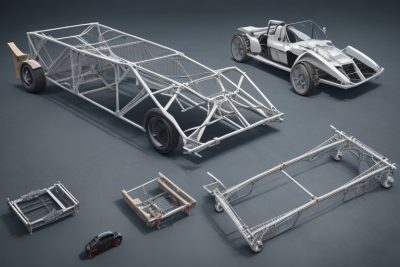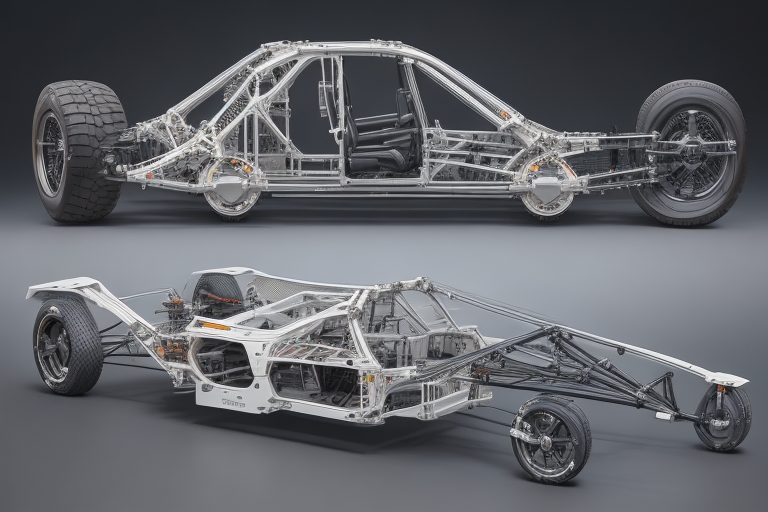The car chassis is a critical component that forms the structural backbone of an automobile. It serves as the platform for various vehicle parts and withstands the pressures of load and external forces.
Understanding the different types of chassis frames is essential for comprehending their applications and advantages. For instance, the monocoque chassis, known for its compact and lightweight design, prioritizes passenger safety and fuel efficiency.
Meanwhile, the ladder-on-frame chassis is commonly used in SUVs, offering flexibility and protection for off-roading.
This article explores these chassis frames to provide a comprehensive understanding of their characteristics and uses in the automotive industry.

Key Takeaways
- The car chassis is responsible for supporting and handling the car’s load, providing mounting locations for various parts, and managing stresses during driving and road conditions.
- There are four main types of chassis frames: monocoque, ladder-on-frame, backbone, and tubular.
- Monocoque chassis is compact and lightweight, suitable for small hatchbacks and SUVs, and offers high safety and fuel efficiency, but may limit off-roading abilities.
- Ladder-on-frame chassis is used in SUVs with off-roading capabilities, provides protection, and enhances off-roading abilities, but may require more effort to drive, and is not suitable for hatchbacks or sports cars.
The Importance of Car Chassis in Vehicle Performance
The performance of a vehicle is greatly influenced by the strength and rigidity of its car chassis, which ensures stability and maneuverability during various driving conditions.
The car chassis serves as the backbone of the vehicle, providing structural support and housing all the major components of the car. It is responsible for handling the car’s load, managing the stresses during acceleration and braking, and withstanding the added pressure of luggage and passengers.
Different types of chassis frames, such as monocoque, ladder-on-frame, and backbone, offer unique advantages and disadvantages, catering to different types of vehicles and driving requirements.
A well-designed and robust car chassis not only enhances the driving experience but also contributes to the safety and overall performance of the vehicle.
Understanding Monocoque Chassis: Construction and Advantages
Significantly, understanding the construction and advantages of a monocoque chassis allows for a comprehensive grasp of its role in enhancing the performance and safety of a vehicle.
A monocoque chassis refers to a single-body structure that houses all mechanical parts and components of a vehicle. Its compact and lightweight construction makes it suitable for small hatchbacks and compact SUVs.
One of the key advantages of a monocoque chassis is its ability to provide high safety for passengers. Additionally, this type of chassis offers budget-friendly options with high fuel efficiency.
The compact and lightweight structure of a monocoque chassis allows it to effectively manage dynamic forces and maintain stability while turning. It also adds to the overall safety of the car and passengers.
However, it is important to note that a monocoque chassis may have reduced off-roading abilities and can be difficult to repair if required.
Exploring Ladder-on-Frame Chassis: Off-Roading Capabilities Unveiled
Exploring ladder-on-frame chassis unveils the off-roading capabilities of SUVs. This type of chassis is commonly used in the manufacturing of SUVs that are designed to handle rough terrains and challenging off-road conditions.
The ladder-on-frame chassis consists of heavy beams supported by smaller ones, providing a separate construction for the cabin and chassis. This design offers several advantages for off-roading enthusiasts. Firstly, it provides enhanced protection to the vehicle, ensuring that it can withstand the demands of off-road driving. Additionally, the ladder-on-frame chassis offers a quieter and more comfortable driving experience, thanks to the separation between the road and the cabin.
However, it is important to note that the increased height of the chassis requires more effort and attention while driving. Moreover, the heavy components of this chassis make it unsuitable for hatchbacks or sports cars.
Overall, the ladder-on-frame chassis is a crucial feature that enables SUVs to excel in off-roading adventures.
Backbone Chassis: Enhancing Stability and Connectivity
The backbone chassis ensures optimal stability and connectivity by effectively managing the forces exerted on the vehicle both during acceleration and while driving on rough roads. This type of chassis frame consists of a rectangular hollow cross-section with a cylindrical tube, which provides better connectivity between the axles and the ground.
The backbone chassis offers stability and effective handling of hits to the ground, making it suitable for various road conditions. It also withstands twists better than a ladder frame, ensuring a smoother driving experience.
However, it does have some drawbacks, such as higher manufacturing costs and the need to open the entire backbone for repairs. Despite these limitations, the backbone chassis remains a popular choice for vehicles that require enhanced stability and connectivity.
Pros and Cons of Different Chassis Frames in Automobiles
When considering the pros and cons of different chassis frames in automobiles, it is essential to evaluate factors such as structural integrity and off-roading capabilities. The choice of chassis frame plays a crucial role in determining the performance and functionality of the vehicle.
For instance, the monocoque chassis offers a compact and lightweight structure, high safety for passengers, and budget-friendly fuel efficiency. However, it may lack off-roading abilities and can be difficult to repair if required.
On the other hand, the ladder-on-frame chassis is ideal for SUVs with off-roading capabilities, providing protection and enhancing the driving experience. However, it may require more effort and attention while driving due to its increased height.
Lastly, the backbone chassis offers better connectivity and stability, effective handling of hits to the ground, and can withstand twists better than a ladder frame. However, it comes with higher manufacturing costs and requires the whole backbone to be opened for repairs.
Factors to Consider When Choosing the Right Chassis for Your Car
Several key factors must be taken into account when selecting the appropriate chassis for your car.
Firstly, consider the intended use of the vehicle. If you are looking for a compact and fuel-efficient car for city driving, a monocoque chassis would be suitable. On the other hand, if you require off-roading capabilities, a ladder-on-frame chassis would be ideal.
Secondly, think about the desired level of safety. Monocoque chassis provide high safety for passengers due to their compact and lightweight structure, while ladder-on-frame chassis offer protection and enhance off-roading capabilities.
Lastly, consider the budget and maintenance requirements. Monocoque chassis are budget-friendly and have high fuel efficiency, but repairs can be difficult. Ladder-on-frame chassis are easy to assemble but may require more effort and attention while driving.
Maintenance Tips for Car Chassis: Ensuring Longevity and Performance
Regularly inspect and clean your car chassis to remove dirt and debris, as well as lubricate the moving parts, in order to ensure optimum longevity and performance.
The chassis of a car is responsible for supporting the vehicle’s weight and providing mounting locations for various components. Over time, dirt and debris can accumulate on the chassis, leading to corrosion and potential damage to the moving parts.
By regularly inspecting and cleaning the chassis, you can prevent these issues and maintain the performance of your car. Additionally, lubricating the moving parts of the chassis will reduce friction and improve the overall efficiency of the vehicle.
Neglecting the maintenance of your car chassis can result in decreased performance, increased fuel consumption, and costly repairs. Therefore, it is essential to prioritize the cleanliness and lubrication of your car chassis to ensure its longevity and optimal performance.
Final Roundup
Understanding the different types of car chassis frames is essential in comprehending their diverse applications and advantages in the automotive industry.
The monocoque chassis offers compactness and lightweight construction, prioritizing passenger safety and fuel efficiency.
The ladder-on-frame chassis provides flexibility and protection, making it suitable for off-roading SUVs.
Meanwhile, the backbone chassis enhances stability and connectivity in certain vehicle designs.
By considering these factors, one can make an informed decision when choosing the right chassis for their car.
